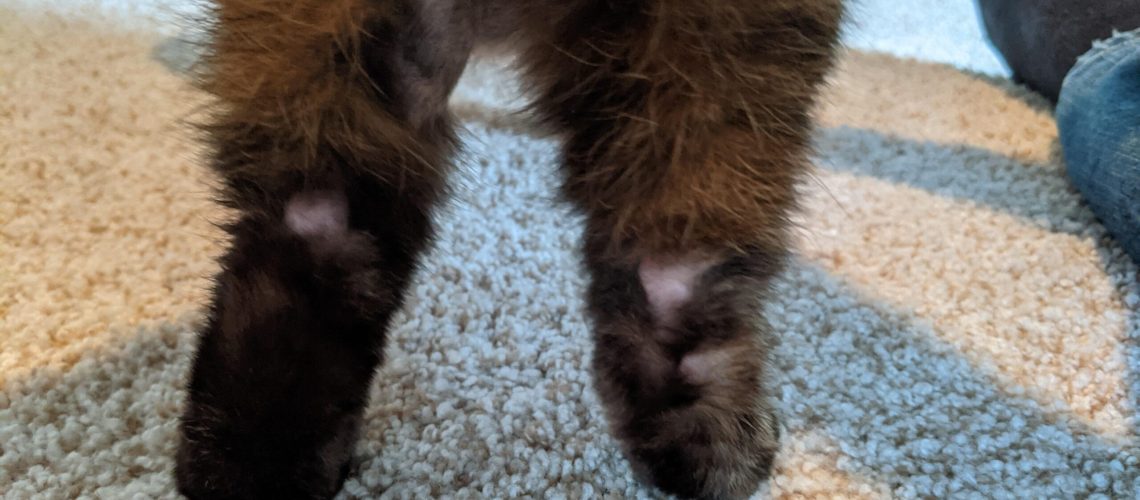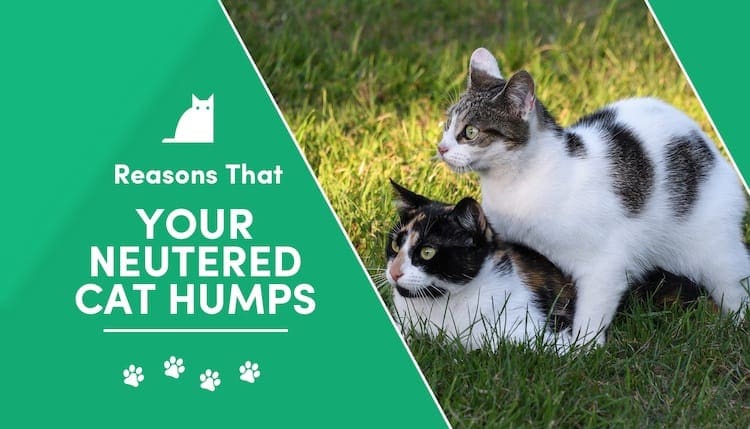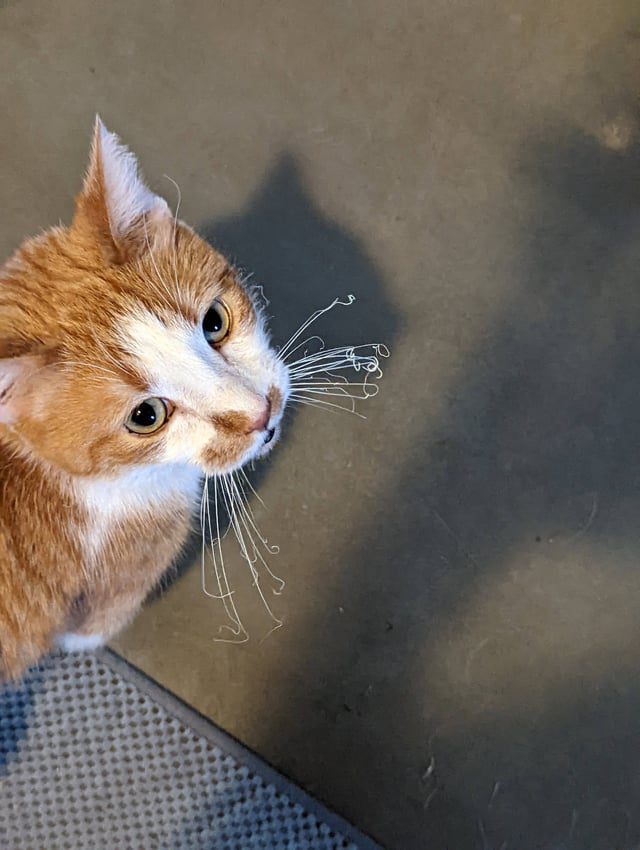Are you a cat lover who is puzzled by the mysterious case of hair loss on your feline friend's hind legs? If so, you're in for a treat! Understanding this topic is not only fascinating but also essential for the well-being of your furry companion. In this article, we will delve into the puzzling world of hair loss on cat's hind legs, uncovering the reasons behind it and providing valuable insights to help you address this issue. So, grab a cup of tea and get ready to unravel the secrets behind your cat's enigmatic hair loss!
Key Takeaways:
- Hair loss on a cat's hind legs can be caused by various factors such as allergies, parasites, or hormonal imbalances.
- It is important to consult a veterinarian to determine the underlying cause of hair loss and provide appropriate treatment.
- Regular grooming and hygiene practices can help prevent hair loss on a cat's hind legs.
- Providing a balanced diet with essential nutrients can promote healthy skin and coat, reducing the risk of hair loss.
- Stress and anxiety can also contribute to hair loss in cats, so creating a calm and comfortable environment is crucial for their overall well-being.
Understanding Hair Loss on a Cat's Hind Legs
Causes and Identification of Hair Loss on a Cat's Hind Legs
Hair loss on a cat's hind legs can be caused by various factors. One common cause is excessive grooming or licking, which can lead to hair thinning or bald patches. Cats have a natural instinct to groom themselves, but if they do it excessively, it can result in hair loss. Another possible cause is allergies. Cats can develop allergies to certain foods, environmental factors like pollen or dust mites, or even flea bites. These allergies can cause itching and irritation, leading to hair loss.
To identify the cause of hair loss on your cat's hind legs, you should closely examine the affected areas. Look for any signs of redness, swelling, or sores that could indicate an underlying skin condition. Check for fleas or flea dirt as well, as flea infestations are a common cause of hair loss in cats. If you notice any other symptoms like excessive scratching, changes in appetite or behavior, or weight loss, it is important to consult with a veterinarian for a proper diagnosis.
Possible Health Issues Linked to Hair Loss on a Cat's Hind Legs
Hair loss on a cat's hind legs can sometimes be an indication of underlying health issues. One possible health issue is dermatitis, which refers to inflammation of the skin. Dermatitis can occur due to allergies, infections, parasites (such as fleas), or autoimmune disorders. It often leads to itching and discomfort for the cat and may result in hair loss.
Another potential health issue linked to hair loss on a cat's hind legs is ringworm infection. Despite its name, ringworm is not caused by worms but rather by a fungal infection that affects the skin and fur. It can spread easily between animals and humans and typically causes circular patches of hair loss with red, scaly skin.
If you notice hair loss on your cat's hind legs along with other symptoms like itching, redness, or sores, it is important to have them evaluated by a veterinarian. The vet will be able to determine if there is an underlying health issue and recommend appropriate treatment.
- Dermatitis
- Ringworm infection
Treatment and Prevention for Hair Loss on a Cat's Hind Legs
The treatment for hair loss on a cat's hind legs depends on the underlying cause. If excessive grooming is the culprit, it may be necessary to address any underlying stress or anxiety that could be triggering the behavior. Providing environmental enrichment, such as interactive toys and scratching posts, can help redirect their focus from excessive grooming. In some cases, behavioral modification techniques or medications may be recommended by a veterinarian.
If allergies are causing the hair loss, identifying and removing the allergen from the cat's environment can help alleviate symptoms. This may involve changing their diet to eliminate potential food allergens or using hypoallergenic bedding and cleaning products. In severe cases, medication or allergy shots prescribed by a veterinarian may be necessary.
For infections or parasites like fleas or ringworm, specific treatments will be required. This might include topical ointments or oral medications to eliminate the infection or parasite infestation.
To prevent hair loss on a cat's hind legs, regular grooming can help keep their fur healthy and reduce the risk of excessive licking or matting. Additionally, providing a balanced diet with proper nutrition can support overall skin and coat health. Regular veterinary check-ups are also essential to catch any potential health issues early on.
Breeds Prone to Hair Loss on their Hind Legs
While hair loss can occur in cats of any breed, certain breeds may be more prone to this issue than others. Here are some breeds that have been reported to be more susceptible to hair loss on their hind legs:
1. Siamese: Siamese cats are known for their short, fine fur, which may make any hair loss more noticeable.
2. Sphynx: Sphynx cats are hairless or have very little hair, so any hair loss on their hind legs would be immediately visible.
3. Devon Rex: This breed has curly and sparse fur, which might make it easier to spot any hair loss.
It is important to note that while these breeds may be more prone to hair loss, it does not mean that all cats of these breeds will experience this issue. Each cat is unique and can have different health conditions or genetic factors that contribute to their overall coat health.
How Long Does it Take for Fur to Grow Back After Hair Loss?
The time it takes for fur to grow back after hair loss on a cat's hind legs can vary depending on the underlying cause and the individual cat's health. In general, it can take several weeks to several months for the fur to fully regrow.
If the hair loss is due to excessive grooming or allergies, addressing the underlying cause and providing appropriate treatment should help promote regrowth. However, if there is an underlying health condition or injury causing the hair loss, it may take longer for the fur to grow back completely.
During the regrowth process, you may notice that new fur appears as soft fuzz before fully maturing into its normal texture. It is essential to continue monitoring your cat's progress and consulting with a veterinarian if there are any concerns or if the fur does not seem to be regrowing as expected.
The Role of Stress and Anxiety in Hair Loss on a Cat's Hind Legs
Stress and anxiety can play a significant role in causing or exacerbating hair loss on a cat's hind legs. Cats are sensitive animals that can easily become stressed or anxious due to changes in their environment, routine, or social interactions.
When a cat is stressed or anxious, they may resort to excessive grooming as a coping mechanism. This can lead to hair loss on the hind legs and other areas of the body. Additionally, stress can weaken the immune system, making cats more susceptible to skin infections and other health issues that can contribute to hair loss.
To help reduce stress and anxiety in cats, it is important to provide a calm and enriched environment. This includes providing hiding spots, vertical spaces for climbing, interactive toys, and regular play sessions. Creating a consistent daily routine and ensuring that your cat has a quiet space where they can retreat when feeling overwhelmed can also be beneficial.
If your cat's hair loss is related to stress or anxiety, consulting with a veterinarian is recommended. They may recommend behavior modification techniques or medications to help alleviate your cat's stress levels and prevent further hair loss.
Causes and Identification of Hair Loss on a Cat's Hind Legs
Hair loss on a cat's hind legs can be caused by various factors. One common cause is excessive grooming or licking due to allergies or skin irritations. Cats may develop allergies to certain foods, fleas, or environmental factors such as pollen or dust mites. These allergies can lead to itching and discomfort, causing the cat to excessively groom their hind legs, resulting in hair loss.
Another possible cause of hair loss on a cat's hind legs is fungal or bacterial infections. These infections can occur when the cat has an open wound or scratch that becomes infected. The bacteria or fungi then multiply and cause irritation and hair loss in the affected area.
To identify the cause of hair loss on a cat's hind legs, it is important to observe the cat's behavior and look for any accompanying symptoms. If the hair loss is accompanied by redness, swelling, or sores, it may indicate an infection. Allergies may be suspected if the cat is frequently scratching other parts of its body as well.
Signs of Hair Loss:
- Patchy or thinning fur on the hind legs
- Redness, swelling, or sores in the affected area
- Excessive grooming or licking behavior
- Scratching other parts of the body
When to Consult a Veterinarian:
If you notice persistent hair loss on your cat's hind legs or any signs of infection, it is recommended to consult a veterinarian for proper diagnosis and treatment.
Possible Health Issues Linked to Hair Loss on a Cat's Hind Legs
Hair loss on a cat's hind legs can sometimes be an indication of underlying health issues. One possible health issue linked to this condition is flea infestation. Fleas are common parasites that feed on cats' blood and can cause severe itching and irritation. When cats scratch or groom excessively to relieve the itchiness, it can lead to hair loss on their hind legs.
Another health issue that may be linked to hair loss is hormonal imbalances. Cats with conditions such as hyperthyroidism or Cushing's disease may experience hair loss as a symptom. These hormonal imbalances disrupt the normal functioning of the body, including the growth and maintenance of fur.
In some cases, hair loss on a cat's hind legs can also be associated with underlying skin conditions like dermatitis or ringworm. Dermatitis is an inflammation of the skin that can be caused by allergies or irritants, while ringworm is a fungal infection that affects the skin and fur.
It is important to note that these health issues are not always the cause of hair loss on a cat's hind legs, but they should be considered if other symptoms are present. Consulting a veterinarian will help determine the underlying cause and provide appropriate treatment.
Common Health Issues Linked to Hair Loss:
- Flea infestation
- Hormonal imbalances (hyperthyroidism, Cushing's disease)
- Skin conditions (dermatitis, ringworm)
Importance of Veterinary Diagnosis:
To accurately identify any potential health issues linked to hair loss on your cat's hind legs, it is crucial to seek professional veterinary diagnosis and guidance for proper treatment and management.
Treatment and Prevention for Hair Loss on a Cat's Hind Legs
Identifying the Underlying Cause
Hair loss on a cat's hind legs can be caused by various factors, including allergies, parasites, infections, or hormonal imbalances. To effectively treat and prevent further hair loss, it is crucial to identify the underlying cause. A veterinarian will conduct a thorough examination and may perform tests to determine the specific cause of the hair loss. Once the cause is identified, appropriate treatment can be prescribed.
Treating Allergies and Infections
If allergies or infections are causing hair loss on your cat's hind legs, your veterinarian may recommend medications such as antihistamines or antibiotics. These medications help alleviate symptoms and promote healing. Additionally, your vet may suggest topical treatments like medicated shampoos or creams to soothe irritated skin and encourage hair regrowth.
Preventing Hair Loss through Proper Grooming
Regular grooming plays a vital role in preventing hair loss on a cat's hind legs. Brushing your cat's fur helps distribute natural oils and stimulates blood flow to the skin, promoting healthy hair growth. It also helps remove loose hairs that can contribute to matting or irritation. However, it is essential to use gentle brushes designed for cats to avoid causing discomfort or injury.
Grooming Tips:
- Use a soft-bristle brush or a grooming glove specifically made for cats.
- Start with short sessions and gradually increase the duration as your cat becomes more comfortable.
- Pay attention to any signs of discomfort or sensitivity during grooming.
- If you encounter mats or tangles, gently work them out using your fingers or a wide-toothed comb.
- Consider consulting a professional groomer if you are unsure about proper grooming techniques.
By addressing the underlying cause of hair loss and maintaining a regular grooming routine, you can help your cat's hind legs regain their furry glory.
Breeds Prone to Hair Loss on their Hind Legs
Persian Cats
Persian cats are known for their luxurious coats, but they are also prone to hair loss on their hind legs. This breed's long and dense fur can easily become matted or tangled, leading to skin irritation and subsequent hair loss. Regular grooming is essential for Persian cats to prevent these issues and maintain healthy fur.
Sphinx Cats
Sphinx cats, with their unique hairless appearance, may seem immune to hair loss. However, they can still experience baldness on their hind legs due to various factors such as allergies or hormonal imbalances. Special care should be taken when handling Sphinx cats' sensitive skin, and regular veterinary check-ups are crucial for early detection and treatment of any underlying conditions.
Siamese Cats
Siamese cats have short coats that generally require less maintenance compared to long-haired breeds. However, they can still experience hair loss on their hind legs due to excessive grooming caused by stress or anxiety. Creating a calm environment for Siamese cats and providing mental stimulation can help reduce the likelihood of over-grooming and subsequent hair loss.
Understanding the breeds prone to hair loss on their hind legs allows cat owners to be proactive in preventing and managing this issue specific to certain breeds.
How Long Does it Take for Fur to Grow Back After Hair Loss?
The time it takes for fur to grow back after hair loss depends on various factors such as the underlying cause, the individual cat's health, and genetics. In most cases, fur regrowth begins within a few weeks once the underlying issue is addressed or resolved. However, complete restoration of a full coat may take several months.
Factors Affecting Fur Regrowth:
- Health: Cats in good overall health tend to have faster fur regrowth compared to those with underlying health conditions.
- Age: Younger cats generally have quicker fur regrowth due to their faster metabolism and cell regeneration.
- Genetics: Some cats naturally have slower fur growth rates, which can affect the time it takes for hair to fully grow back.
It is important to note that during the regrowth process, the appearance of the new fur may differ from the original coat. The color or texture might vary temporarily, but it should gradually return to its normal state over time. Patience and proper care are key when waiting for your cat's fur to grow back after hair loss.
The Role of Stress and Anxiety in Hair Loss on a Cat's Hind Legs
Stress and anxiety can contribute to hair loss on a cat's hind legs, often resulting from excessive grooming behavior known as psychogenic alopecia. Cats may excessively lick or chew their hind legs as a coping mechanism when feeling stressed or anxious. This self-grooming behavior can lead to hair loss and skin irritation.
Identifying Stress Triggers
To address stress-related hair loss, it is crucial to identify potential triggers in your cat's environment. Common stressors include changes in routine, introduction of new pets, loud noises, or lack of mental stimulation. By recognizing these triggers, you can take steps to minimize their impact on your cat's well-being.
Creating a Calm Environment
Providing a calm and enriched environment is essential for reducing stress and preventing excessive grooming. Ensure your cat has access to hiding spots, scratching posts, toys, and interactive playtime. Establish consistent routines and provide a quiet space where your cat can retreat when feeling overwhelmed.
Tips for Reducing Stress:
- Maintain a predictable daily routine.
- Provide vertical spaces like cat trees or shelves for climbing and observing their surroundings.
- Use interactive toys or puzzle feeders to mentally stimulate your cat.
- Consider using pheromone diffusers or calming sprays to create a soothing atmosphere.
If stress and anxiety persist despite environmental modifications, consult with a veterinarian who can recommend additional strategies or medications to help alleviate your cat's anxiety and prevent further hair loss on their hind legs.
In conclusion, hair loss on a cat's hind legs can be caused by various factors such as allergies, parasites, or excessive grooming. It is important to consult a veterinarian to determine the underlying cause and provide appropriate treatment for our furry friends.
Why is my cat losing hair on his back legs?
While it is usually not a cause for alarm, it is still advisable to bring your cat to the veterinarian for a general health examination. There are various reasons why your cat might be experiencing hair loss, such as an inadequate diet, allergies, infestations of fleas and ticks, stress, or even hypothyroidism.
What causes leg hair loss?
In addition to PAD, other factors that can cause hair loss on the lower legs include diabetes, circulation problems, thyroid issues, fungal infections, advanced stages of folliculitis, hormonal changes, and disorders of the pituitary gland. This information was reported on June 19, 2023.
Why is my elderly cat losing fur?
Scratching without control can be caused by allergies to cat food, flea bites, lice, ear mites, scabies, and ticks. Additionally, pain or discomfort, such as from arthritis or broken bones, can result in excessive licking and hair loss in the affected area. This can occur in both cats and dogs.
What is the skin disease that cats lose their hair?
Mange is a skin condition that causes inflammation, and it is caused by different types of mites. Some of these mites cannot be seen with the naked eye and require a microscope to identify. These mites live and dig into a cat's skin and fur, leading to excessive scratching, swelling, and hair loss in areas such as the face, eyelids, neck, and back.
What does mange look like on a cat?
Symptoms of the condition include hair loss in patches, rashes on the skin, small red bumps that initially appear on areas without hair or light fur and then spread over time, and the development of crusty sores on the skin.
What do mites on cats look like?
These tiny white dots, although difficult to see without magnification, are actually ear mites. They reside in the ear canal and survive by consuming ear wax and skin oils. Typically, an adult ear mite has a lifespan of approximately two months, but they have the ability to reproduce rapidly.

















